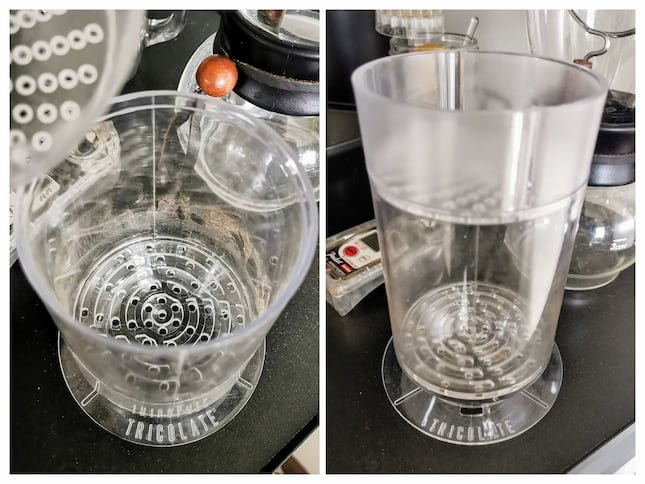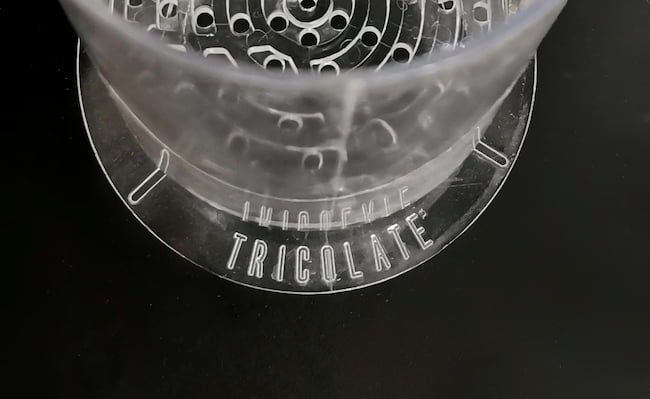The Tricolate is a new coffee brewer that seems a little bit like something we have seen before but not quite.
It promises ridiculously high extractions and a consistent brewing experience.
I have been brewing with it for several months now, so I’m ready to tell you whether it lives up to the promises.
➡️ Available at Prima Coffee.
About Tricolate
Tricolate comes from Australia and is produced by what seems like a small and relatively new outfit.
However, I guess that the people behind it are not entirely new to the coffee industry. They do a lot of things right when it comes to communication and branding.
In a few ways, you can tell that this is a startup, though. For instance, the product seems to be still undergoing some minor tweaks and improvements.
As far as I can see, both the dispersion screen and the filter holder have changed a few times over the last year.
Also, the boxes on the website feature an 80’s sci-fi branding, whereas the one I received was decorated with an elaborate type of Kraken/squid decoration.
The Tricolate is made of Tritan, which according to the experts, is state-of-the-art when it comes to plastic.

The device comes with 100 filters, which are described as “laboratory-grade paper filters from Germany.”
The filters are 80 mm, so they would probably be difficult to buy elsewhere. This is a bit unfortunate since they are relatively expensive to get from the company.
Tricolate Review: Daily Use
The company promises many exciting things on their website, but the gist is that without much effort, this brewer allows you to brew extremely-high extraction coffee.
We are talking 1:22 ratios here 😲
This promise is going to be highly compelling to a specific segment of coffee geeks.
I was never really a big fan of these crazy-high extractions. After all, you drink coffee with your tastebuds, not with a refractometer. So why care that about extraction yield? After a certain point, it’s just diminishing returns and comes at serious risk of making a dull or dry-tasting cup.
The Tricolate promises to achieve high extractions by using a broader and more shallow brew bed while not allowing any bypass whatsoever.
There are two different approaches suggested on the site: One uses a standard 1:16.6 ratio, and the other uses a 1:22 ratio.
At first, I was very frustrated with the brewer. The suggested recipes didn’t make a tasty cup to me.
Especially, the longer ratios were disappointing.
It felt as if the dispersion screen was not doing a great job.
Yes, it was indead spreading the water across the surface. However, the flow was too fast and forceful for my liking.

This resulted in a brew where I would bloom, give a quick swirl (as per the instructions), and then after the second pour, end up with a massive column of water above the brew bed.
This would slowly trickle down after 5-7 minutes.
My theory is that the powerful agitation from the water would cause fines to migrate to all parts of the brew bed and stall the brew.
The resulting cups were somewhat sweet but lacking in clarity and complexity. Overall, it just wasn’t my type of coffee.
⚠️ Update 2022: Tricolate has updated the dispersion screen, so it’s now more to my liking. The flow on the new screen is slower and does a better job at distributing the water across the brew bed. It’s still not as good as using a Gabi Drip Master B, so if you have one, I still encourage you to give it a try.
The company has also changed size of the paper filter, so it’s easier to insert, as well as the filter holder disk.
Overall, all these updates are very welcome. However, fixing the dispersion screen has been the most crucial point.
My tricolate recipe
At one point, I was very close to giving up the brewer. But then I changed my approach slightly. This method gave the brewer a completely new lease on life!
The dispersion screen that comes with the Tricolate looks sophisticated and innovative. But in my opinion, it’s both inconsistent and too fast. So I wondered what would happen if I used the Gabi Dripmaster instead?
The Gabi has a slow and very consistent flow rate. Usually, you have to use some manual agitation when using it; however, due to the slightly taller stature of the Tricolate combined with the wide and flat brew bed, it turned out that the natural agitation from the Gabi shower screen was sufficient.
After experimenting with both shower screen A and B from Gabi, I came to prefer A since it is a bit slower while having less thermal loss. In addition, it seemed to be more suitable for a somewhat more lazy brew; just keep refilling it. Then wait.
A brief look at the Tricolate/Gabi combo
In the end, I settled on this recipe:
- Use 1:18 ratio.
- Medium grind size. (Comandante: 24-26 clicks)
For example: 11g/200ml or 16.5g/300 ml - Use 5 times the coffee weight for the bloom. Bloom and then wait 1 minute
- Slowly pour the remainder of the water, making sure that the water column doesn’t go higher than 1 inch.
Go for a flow rate of 1-2 ml per second.
(This is a lot easier if you’re using a dispersion screen, like the Gabi A or B. Hario Drip Assist or Melodrip might also work) - Finish time at 4-4:30 minutes
- The brew bed should look like sand on the beach. Not muddy or silty.
I was getting some remarkably consistent, easy, and delicious cups of coffee this way. Similar to the best pour over coffee makers in many ways, but with a way higher extraction yield.
After a few weeks of this, I realized that the Tricolate had become my daily driver, more or less.
The cups tasted extremely balanced, clear, and well-extracted. And they were so easy to make.
Plus, brewing at 1:18 is still a very economically friendly way to brew.
Later, I started using the Tricolate as an alternative to other lazy methods, such as the Clever Dripper and Hario Switch, when I had family visiting. I will say that you can comfortably brew around 600-700 ml’s (3-4 cups) and you don’t need to spend much time watching the brew. It’s relatively forgiving.
Tricolate Review: Final verdict
I think the Tricolate has a lot of potential, and I’m pleased to have it in my brewer collection.
It looks cool in a sci-fi way, and is unlike most other gadgets in my collection.
The first versions of the brewer didn’t have an ideal dispersion screen, but on the current 2022 version, this issue has more or less been fixed.
Read More: AeroPress vs Pour Over
With the new and upgraded dispersion screen, it’s possible to emulate the hybrid-brews if you have a steady hand.
You’ll have to hold the kettle completely still while opting for a flow rate between 1-2 ml per second.
The dispersion screen could be even better, but it’s totally acceptable now.
While I won’t give it a 5 star rating, I still think the Tricolate deserves a spot in your collection if you’re a sufficiently big coffee geek.
It’s a unique brewer that opens up the door to next-level extractions, as well as being very consistent and efficient when making slightly bigger batches.
As I have been using the Tricolate more and more over the last months, it has won me over.
➡️ See the current price here.
